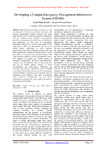| dc.description.abstract | Mobile phone technology is driving not only
communication but also increasingly emergency and
disaster management. Natural disasters and manmade threats such as terrorism constitute emergencies
that are common today. Cellular communication
provides a tremendous potential to increase efficiency
and effectiveness in this area by propagating
information efficiently to all the right parties in the
right places. There are opportunities for the use of
mobile phone technology in early warning,
preparedness and other mitigation activities that can
help organizations in Kenya to build resilience in the
face of the ever growing threat of such disasters. This
study therefore explores, from an institutional context,
how students in campus use mobile phones in
emergency management, the factors underlying their
extensive use, the challenges that are faced and how
this use of mobile phones related to social
organizations and interactions. Ultimately, an
emergency management information system (CEMIS)
is developed that utilizes the power of text messaging
to build resilience in the face of ever growing threat of
emergencies and disasters. The study recommends
more proactive developments in text based
applications to mitigate the adverse effects of disasters
in institutions of learning. | en_US |

